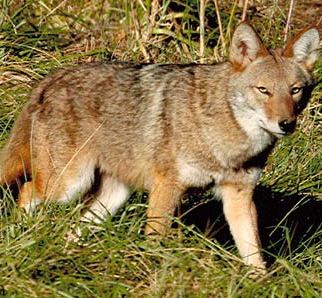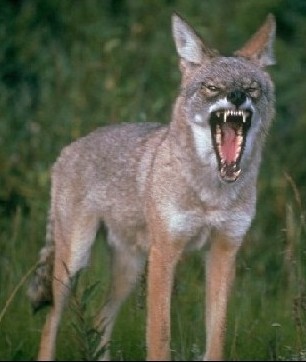|
The wily coyote, so deeply rooted in the history and lore of the American West, is a newcomer to the Alaska scene. Coyotes were first noted in the state shortly after the turn of the 20th century. Populations were first reported on the mainland of Southeast Alaska and then slowly expanded northward into the upper Tanana Valley from which they radiated in all directions. A population peak occurred around 1940; since that time numbers have declined in many areas. Portions of the state with the highest densities of coyotes are the Kenai Peninsula, the Matanuska and Susitna valleys and the Copper River Valley.
The coyote, like the wolf, is a member of the dog family (Canidae) and resembles a medium-sized shepherd-collie type dog. Distinctive features of the coyote are its sharp pointed ears that never droop, a sharp pointed nose, and long bushy tail. The legs of the coyote are generally slimmer and the feet smaller than those of a dog of comparable size. Coyotes average 22 to 33 pounds or about one-third the size of wolves. Males are slightly heavier than females. Coyotes average 2 feet high at the shoulder and, including tail, are approximately 4 feet long. The summer coat is predominantly gray, washing into tan along the belly, lower legs, muzzle, and ears.
The coyote is best described as an opportunistic feeder. In Alaska snowshoe hares, microtine rodents, and carrion comprise the bulk of the coyote's diet while marmots, ground squirrels, muskrats, fish, insects, and even Dall sheep are taken in fewer numbers. Coyotes hunt singly, in pairs, and occasionally in packs. They sometimes hunt cooperatively and have been observed using techniques such as chasing prey animals in relays, which allows them to capture animals that could outrun a single coyote. The coyote's method of capturing microtine rodents is similar to that of the fox.
Coyotes breed between January and March. A mated pair may stay together through the spring and share parental duties after the pups are born. Other coyotes, especially young of the previous years, may also help care for the pups. Shortly before whelping, one or more dens are prepared for the litter. Coyotes give birth to an average of five to seven blind and helpless pups. The size of litters varies in response to the food supply. Litters born in times of plenty will, on the average, be larger than those born when food resources are scarce. For the first three weeks the young coyotes subsist entirely on milk. About this time some solid food regurgitated by the females is introduced into their diet, and the pups are weaned at five to seven weeks. Once the pups establish a pattern of eating regurgitated food they will induce the parents to regurgitate by licking, biting, and clawing at their lips.
At the age of three to three-and-a-half months, pups are able to capture food for themselves. Coyotes den in a variety of protected places and frequently take over the dens of other animals. It is not unusual for coyotes to move their pups to other dens. Family units may begin to break up as early as August, although is not unusual for them to remain together into November or even later. Coyotes are generally less social than wolves, but the adult female and male pair is the basic social unit that maintains a territory and may remain together for several years.
The scientific name of the coyote, Canis latrans, literally means barking dog. Coyotes exhibit a variety of vocalizations. They can bark like dogs, though the sounds most often heard are shrill yips and howls. Howling is often a group effort, perhaps beginning as a simple howl, but quickly increasing in intensity to a series of group howls and high-pitched barks. Howling may function as a greeting between coyotes or as a territorial claim between groups. The most common call is a long, mournful high-pitched howl which ends in a series of sharp yips and yaps. Like other canids, the coyote is susceptible to rabies, distemper, and other diseases which may cause periodic declines in coyote populations.
Coyotes are elusive. They are more active at dawn and dusk, but can be seen almost anytime during the day or night. Home-range size depends on geographic and seasonal factors. Coyotes can have a home range of 1,500 to 12,000 acres. This is just one more animal that relies on large amounts of connecting native lands to survive Coyotes may travel individually or in groups of two or three. Food is an important factor in coyote population densities.
Coyotes have one breeding cycle per year. The male, unlike the domestic dog, has active sperm only in late winter when females are in heat. Coyotes can first breed when they are 10 months old. The proportion of the yearling females that breed varies as a function of food supply: in good years, a higher proportion breed than in years when food is scarce. A mating pair might breed from year to year but not necessarily for life. Coyotes can breed with domestic dogs and produce fertile offspring. Hybridization, or the mating of two individuals of different species, occurs infrequently in the wild. Coyotes breed in late winter. Following a 63-day gestation period an average of 6 coyote pups are born.
|







